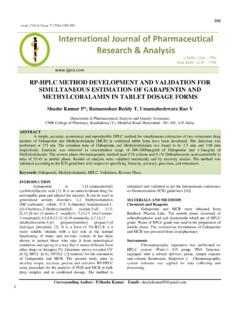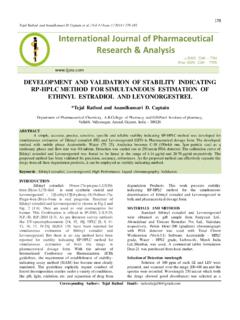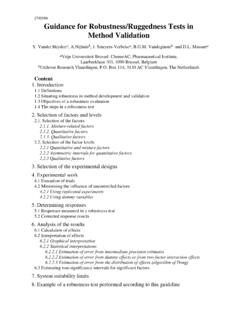Transcription of HPLC METHOD DEVELOPMENT AND VALIDATION: AN …
1 274 Santhosh al. / Vol 4 / Issue 4 / 2014 / 274-280. hplc METHOD DEVELOPMENT AND validation : AN OVERVIEW G. Santhosh*, , , Maheswara Rao Department of Pharmaceutical Analysis and Quality Assurance, CMR College of Pharmacy, Medchal Road, Kandlaykoya, Hyderabad, India. ABSTRACT High performance liquid chromatography ( hplc ) is an analytical technique which is proficient to separate, detect and quantify various drugs and its related degradants. An appropriate mobile phase, column, column temperature, wavelength and gradient must be found that affords suitable compatibility and stability of drug as well as degradants and impurities. This review covers the importance of RP- hplc in analytical METHOD DEVELOPMENT and their strategies along with brief knowledge of critical chromatographic parameters need to be optimized for an efficient METHOD DEVELOPMENT .
2 Keywords: METHOD validation , METHOD DEVELOPMENT , High PressureLiquid Chromatography ( hplc ). INTRODUCTION hplc is an analytical technique in which solutes are resolved by differential rates of elution as they pass through a chromatographic column. The METHOD of separation by this instrument is governed by distribution between the mobile phase and stationary phase. The instrumentation is made-up of eight basic components, mobile phase reservoir, solvent delivery system, sample introduction device, column, detector, waste reservoir, connective tubing and computer, integrator or recorder. The successful use of hplc for the possible problem requires the right combination of variety of operating conditions such as the type of column packing and mobile phase, column length and diameter, mobile phase flow rate , column temperature and sample size [1].
3 Now a day reversed-phase chromatography is the most commonly used separation technique in hplc due to its broad application range. It is estimated that over 65% (possibly up to 90%) of all hplc separations are carried out in the reversed phase mode. The reasons for this include the simplicity, versatility and scope of the reversed-phase METHOD as it is able to handle compounds of a diverse polarity and molecular mass [2-4]. PRINCIPLE In isocratic hplc the analyte is forced through a column of the stationary phase (usually a tube packed with small round particles with a certain surface chemistry) by pumping a liquid (mobile phase) at high pressure through the column.
4 The sample to be analyzed is introduced in a small volume to the stream of mobile phase and is retarded by specific chemical or physical interactions with the stationary phase as it traverses the length of the column. The amount of retardation depends on the nature of the analyte, stationary phase and mobile phase composition. The time at which a specific analyte elutes (comes out of the end of the column) is called the retention time and is considered a reasonably unique identifying characteristic of a given analyte. The use of pressure increases the linear velocity (speed) giving the components less time to diffuse within the column, leading to improved resolution in the resulting chromatogram.
5 Common solvents used include any miscible combinations of water or various organic liquids (the most common are methanol and acetonitrile). Water may contain buffers or salts to assist in the separation of the analyte components. A further refinement to hplc has been to vary the mobile phase composition during the analysis, this is known as gradient elution. A normal gradient for reverse phase chromatography might start at 5% methanol and progress linearly to 50% methanol over 25 minutes, Corresponding Email:- International Journal of Pharmaceutical Research & Analysis e-ISSN: 2249 7781 Print ISSN: 2249 779X 275 Santhosh al.
6 / Vol 4 / Issue 4 / 2014 / 274-280. depending on how hydrophobic the analyte is. The gradient separates the analyte mixtures as a function of the affinity of the analyte for the current mobile phase composition relative to the stationary phase. This partitioning process is similar to that which occurs during a liquid-liquid extraction but is continuous, not step-wise. In this example, using a water/methanol gradient, the more hydrophobic components will elute (come off the column) under conditions of relatively high methanol; whereas the more hydrophilic compounds will elute under conditions of relatively low methanol.
7 The choice of solvents, additives and gradient depend on the nature of the stationary phase and the analyte. Often a series of tests are performed on the analyte and a number of generic runs may be processed in order to find the optimum hplc METHOD for the analyte - the METHOD which gives the best separation of peaks. APPLICATIONS Preparative hplc refers to the process of isolation and purification of compounds. Important is the degree of solute purity and the throughput, which is the amount of compound produced per unit time. This differs from analytical hplc , where the focus is to obtain information about the sample compound.
8 The information that can be obtained includes identification, quantification, and resolution of a compound. Chemical Separations can be accomplished using hplc by utilizing the fact that certain compounds have different migration rates given a particular column and mobile phase. Thus, the chromatographer can separate compounds (more on chiral separations) from each other using hplc ; the extent or degree of separation is mostly determined by the choice of stationary phase and mobile phase. Identification of compounds by hplc is a crucial part of any hplc assay. In order to identify any compound by hplc a detector must first be selected.
9 Once the detector is selected and is set to optimal detection settings, a separation assay must be developed. The parameters of this assay should be such that a clean peak of the known sample is observed from the chromatograph. The identifying peak should have a reasonable retention time and should be well separated from extraneous peaks at the detection levels which the assay will be performed. To alter the retention time of a compound, several parameters can be manipulated. The first is the choice of column, another is the choice of mobile phase, and last is the choice in flow rate. All of these topics are reviewed in detail in this document.
10 Identifying a compound by hplc is accomplished by researching the literature and by trial and error. A sample of a known compound must be utilized in order to assure identification of the unknown compound. Identification of compounds can be assured by combining two or more detection methods. Types of hplc methods 1. Reverse Phase hplc Reversed phase chromatography has found both analytical and preparative applications in the area of biochemical separation and purification. Molecules that possess some degree of hydrophobic character can be separated by reversed phase chromatography with excellent recovery and resolution [5].









